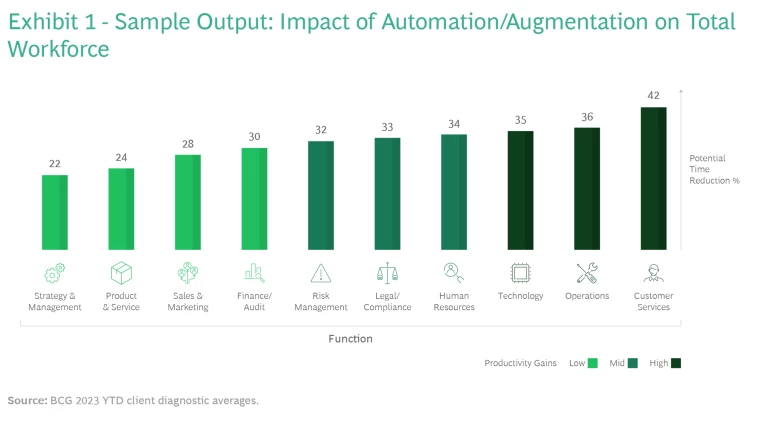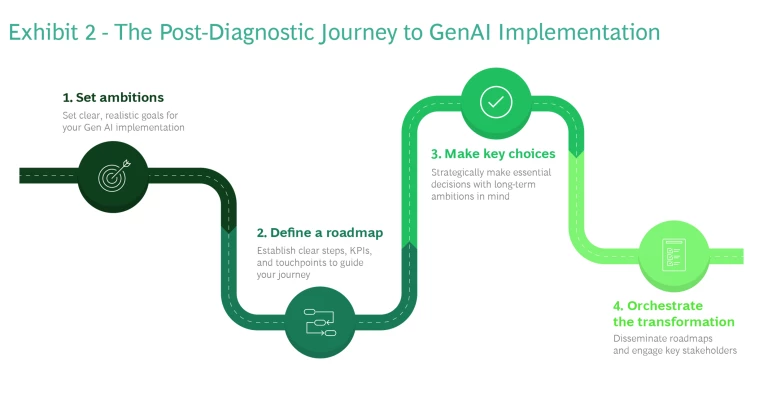When considering how to implement generative artificial intelligence (GenAI), many leaders find themselves in a fog with a murky path forward. Swirling around them are promises of potential benefits and bold yet conflicting messages from GenAI providers, enterprise platform players, press, and social media—not to mention scrutiny from boards, regulators, and workforce representatives. While the value and transformation potential of GenAI are real, so too are the technical, implementation, and change management challenges. The resulting complexity can delay or even dissuade leaders from implementing this game-changing technology.
We recently published research in partnership with Harvard Business School, Wharton, MIT, and other institutions that highlights the need for thoughtful consideration about how people work to capture the full value of this disruptive technology and avoid its pitfalls. The value at stake lies not only in the promise of greater efficiency but also in the possibility that GenAI will free people to redirect time, energy, and effort to more value-adding tasks where humans excel. To identify which actions should be pursued, leaders must take a strategic approach to understanding where GenAI will create value within their organizations through productivity enhancement and business process reimagination—as well as the biggest challenges they will face.
This strategic approach should be grounded in a thorough diagnostic. BCG’s GenAI Workforce Productivity Diagnostic helps a company identify value pools and workforce implications before attempting to implement the technology. The results of this diagnostic will inform an enterprise-level strategy for the technology’s implementation journey—from setting ambitions to defining the roadmap, making key choices, and orchestrating the transformation—that can unlock value fast. Without this clarity, companies can waste valuable time figuring out how to begin their GenAI-enabled transformation, putting value capture and competitive differentiation at risk.
Identifying the Value Pools
The first step in the diagnostic is sizing the potential benefits of GenAI based on the company’s unique characteristics, including its digital maturity and business strategy. GenAI augmentation can deliver value in various ways, including faster feature delivery, enhanced customer centricity, better quality and experience, and financial savings.
The diagnostic should evaluate the impact of GenAI on workforce productivity at every level of the organization and across each function. It is crucial to understand which activities will be augmented by GenAI and to ensure that the company prioritizes the most promising and impactful initiatives. Capturing the projected value will frequently require a holistic reimagination and re-engineering of workflows as well as using the most appropriate GenAI, AI, and digital tools. The diagnostic provides clarity on where to begin and how to sequence the efforts. It also helps leaders identify areas where quick wins to demonstrate value align with specific strategic objectives of the broader enterprise.
The time-saving potential of GenAI can vary significantly based on industry-specific contexts. With this in mind, BCG’s diagnostic can help to quantify company-specific productivity gains and balance the possibly daunting investment needs with tangible value outcomes. For example, BCG recently conducted a diagnostic assessment with a biopharma organization. We assessed 80% of the roles in the firm’s workforce—analyzing each job at an activity level and the potential GenAI impact for each activity to form a comprehensive and traceable view of the opportunity. (See Exhibit 1.) We found that support functions such as technology, operations, and customer support showed the highest potential productivity gains from GenAI deployment. The firm was able to use these insights to build a holistic GenAI roadmap with investment sequencing and implementation considerations. By building a clear value case rooted in data, leaders were able to justify the investment (offsetting costs through rapid value capture) and secure the support of senior executives and other stakeholders.

Assessing the Workforce and Skilling Implications
After identifying the potential areas of value, the next diagnostic step is a comprehensive assessment of how employee roles and skills need to evolve to capture the GenAI benefits. BCG’s GenAI Workforce Productivity Diagnostic tool also provides granular detail, identifying how to transform individual sub-functions and job roles most optimally. There will be implications for workflow design (how to streamline and automate processes), workforce capacity, and workforce responsibilities. In turn, organizations must deliberately design talent initiatives and upskilling programs to equip their workforce with the skills to thrive in the new GenAI-enabled environment and attract individuals capable of harnessing GenAI’s potential.
As with many business transformations, the associated workforce challenges can be as vexing as the technology challenges. But a rigorous diagnostic can help leaders anticipate and pre-emptively address pain points by, for example, explaining to the workforce how and why the company is using GenAI and what skills training is necessary, and how these initiatives create new opportunities for individuals. One important takeaway from a diagnostic is where to target coaching by identifying highly impacted jobs, which may include senior leadership positions. While managing workforce implications is not easy, deploying GenAI without a focus on this kind of organizational transformation will significantly undermine the ability to optimize the results and will diminish the value generated.
Applying the Diagnostic Results
With the diagnostic complete, leadership can apply the results to the entire arc of the technology’s implementation from setting the ambition all the way to orchestration—treading a clear pathway in a once foggy terrain. (See Exhibit 2.)

1. Setting ambitions. By identifying value pools within the organization and prioritizing them, a diagnostic helps the company articulate ambitions that are both aspirational and realistic.
2. Defining a roadmap. By baselining current value potential across the organization—through both productivity and business process innovation—this diagnostic creates a starting point, identifies key steps, and outlines a roadmap to unlock value in the immediate term and lay the foundation for future deployment waves. Many of the biggest opportunities will not simply materialize by deploying a few GenAI-enabled activities. They will require an end-to-end reimagination of workflows incorporating GenAI, AI, and digital tools into the redesign. Initiatives must be company-specific, and early examples may include talent acquisition, campaign creation, sales support, and customer services engagement models.
3. Making key choices. Leaders must choose how to define and track success, sequence technology deployment, drive adoption and transform ways of working, and ensure the responsible use of GenAI. A diagnostic is an essential input to highlight procedural needs, make sequencing decisions, and illuminate how corporate culture must adjust.
4. Orchestrating a transformation. This stage involves the “how” of the transformation. Once the roadmap and key decisions are clear, leaders can determine how to execute the different component pieces in a cohesive and mutually reinforcing way. For example, leaders can:
- Define how to support pilots in a repeatable fashion, with sound experimental design (baseline, control groups, key performance indicators); feedback loops; and learnings capture.
- Guide when the redesign of a series of functional workflows pivots into the holistic redefinition of a whole function.
- Coordinate common upskilling initiatives as well as workflow-specific education needs.
- Address common change management themes, from the worries of the workforce to the evolving role of leaders along the GenAI transformation journey.
The ability to look at all the GenAI activities across the company will help to ensure that the sum of efforts is greater than its parts and leads to transformative change, as opposed to incremental refinement of the enterprise.
Without a diagnostic, even the most digitally mature firm will fly blind in its attempts to capture value and competitive advantage from GenAI deployment. BCG’s GenAI Workforce Productivity Diagnostic, combined with our project experiences, is one of the most effective ways for any company to cut through the GenAI fog and confidently explore the possibilities of this transformative technology. It can help leaders fully leverage their organization’s capabilities, maximize productivity gains, and reimagine their business processes.













